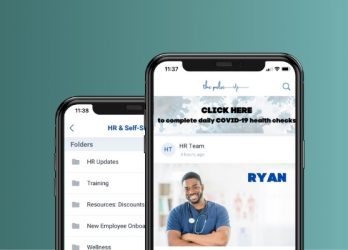Getting ahead of key HR technology trends can set you up for success in 2024. Read this blog to learn more about the state of HR tech and how you can use it to unlock better retention and business results.
What is HR Technology?
Human resources (HR) technology, often referred to as HR tech, encompasses a broad range of digital tools, software, and platforms designed to streamline, enhance, and optimize various aspects of human resources management and workforce administration.
These technologies are specifically developed to assist HR professionals with:
- Managing employee data
- Recruiting new hires
- Talent management
- Payroll
- Employee benefits administration
- Compliance
- HR communication
Ultimately, HR technology aims to improve the overall employee experience, increase operational efficiency, and enable data-driven decision-making within organizations.

Current HR Technology Trends
The world of HR tech is always rapidly evolving. Keeping up with labor management and labor relations trends is key to retaining and maximizing the potential of your workforce.
Watch out for these HR technology trends for the year ahead and start updating your HR communication plan to stay current.
Artificial Intelligence (AI)
The popularization of AI in the workplace is going to change the way we work forever. But it’s critical to figure out the right ways to use AI for HR as well as your policies for how employees can use AI for their work.
Using AI can unlock new levels of productivity and creativity, but it has to be regulated. We’ll begin to see more legislation around AI in the workplace, and we have to be prepared to adapt our use of AI as new policies come about.
Employee Value Proposition (EVP)
An employee value proposition is the whole package you offer your employees. And the technology you provide as a HR team is a big part of that.
The big issues right now that companies need to focus on are:
- Work-life balance and employee wellbeing. 40% of HR leaders plan to train their staff about the importance of employee wellbeing as well as steps to improve it. But you’ll need the technology to support your initiatives.
- Communication gaps for frontline workers (and distributed teams). What good is your employee benefits package if it’s hard to enroll and check your benefits? Your employee training program is useless if your employees can’t access it.
- Learning management. Finding the right LMS or microlearning platform can take your learning and development programs to the next level. Learning has to be accessible, digestible, and targeted for your teams. And the big trend here is going to be supporting your managers and training them to be better managers.
Hiring and Retention of Workers
Retention is always going to be trending in the HR space. It’s just the reason for retention that is going to shift. With 2023 being a year of layoffs and looming recession fears, the talent market has been through a lot.
But in addition to layoffs, many workers have been pursuing other opportunities with better pay, benefits, and flexibility.
To remain competitive, your organization is going to need to invest in HR technology that can help you hire and retain talent. Improving the employee experience really does begin with the hiring and onboarding process, so investing in the right talent solutions is key.
Connecting a Distributed Workforce
Regardless of where your company stands on the return to office vs. remote work debate, we all need to be prepared to embrace the future of the workplace. If you’re a company that also employs frontline workers, for instance, you’ll have a distributed workforce regardless of where your corporate staff work.
So, we need to invest in HR technology that supports hybrid and remote working as well as our deskless workers. That’s going to include:
- Internal communication and collaboration software that’s mobile-optimized and accessible from anywhere.
- Better new hire onboarding technology to support bringing on employees who might never come into an office location.
- Employee training software—note that nearly half of HR leaders are focused on providing remote and hybrid training opportunities.
Digital Employee Experience (DEX)
As we begin to support a more dispersed workforce, we need to re-evaluate the digital employee experience at our companies.
Even before the rise of remote work, the digital workplace was becoming crowded. How many passwords do you expect employees to remember? How many solutions and internal comms channels do they have to access to do their jobs?
Too much tech accessed from too many platforms is overwhelming.
That’s why one of the most important HR technology trends for 2024 is going to be simplifying our tech stacks. And that doesn’t just go for HR tech—it’s all technology your business uses.
The future of our digital experiences has to be creating easy-to-use hubs of information and resources. Employees should only need to log in to one solution to find all employee communications, updates, and resources for work. All your HR integrations should live in this hub. Simple. Straightforward. Easy.

Finding the Right HR Technology Solutions
These recommendations will help you navigate the process of selecting HR technology that aligns with your company’s goals and sets you up for success in 2024 and beyond.
- Assess Your Needs: Begin by clearly defining your organization’s specific HR needs and objectives. Understanding what you require is the foundation for selecting the right HR technology.
- Vendor Reputation: Research potential vendors thoroughly. Look for testimonials, case studies, and reviews to gauge their reputation. A well-regarded vendor is more likely to provide a reliable solution.
- Compatibility: Ensure that the HR technology integrates seamlessly with your existing systems and software. Compatibility issues can lead to inefficiencies and data discrepancies, so prioritize a system that works well with your current setup.
- Scalability: Consider your organization’s growth potential. Choose HR technology that can accommodate a growing workforce and evolving needs. Scalability ensures the long-term value of your investment.
- User-Friendliness: Opt for HR solutions that are intuitive and user-friendly. Complex systems can discourage adoption, so prioritize ease of use to ensure that employees can make the most of the technology.
Subscribe To The theEMPLOYEEapp Newsletter
Comments are closed.




